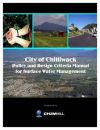Stormwater Detention: Ten proven ways to cheat
“Have you ever felt that justifying your detention design to a reviewing agency was a game of numbers? Do you have ways of making that marginal design look like a winner? Most engineers do,” wrote Glenn E. Brooks in the September 2007 issue of Stormwater magazine.
Chilliwack Policy and Design Criteria Manual for Surface Water Management

Chilliwack Manual, May 2002 (360 pixels)
City of Chilliwack
The City of Chilliwack’s Policy and Design Criteria Manual for Surface Water Management serves two purposes. It provides a comprehensive framework that will guide the development of individual Master Drainage Plans over a multi-year period; and it provides land developers with specific direction in undertaking the stormwater component of sustainable urban design.
Urban Density, Meteorology, and Rooftops
In recent years, there has been a recognition in Australia and elsewhere of the many favourable aspects of denser urban development, and a corresponding move towards promoting it in urban plans such as Melbourne 2030. In a paper by Carol Skinner, published in Urban Research and Policy in September 2006, the many appealing aspects of denser cities are summarised.
Washington State conference showcases British Columbia approach to rainwater management

The pilot for Beyond the Guidebook is the City of Surrey’s Fergus Creek Watershed Plan. The plan is precedent-setting because there will be no large-scale storage ponds. “Rather, rainwater runoff volume will be managed through constructed facilities and the creation of contiguous large-scale greenways that have been integrated into the area’s land use plan”, stated Remi Dube.
Climate Change Adaptation and Urban Reforestation in Delta, British Columbia
About 1/3 of the urban landscape is typically covered by road rights-of-way. This creates opportunities to capture rain where it falls and restore it to natural hydrologic pathways. In British Columbia, Delta municipality is planting an urban forest to mitigate climate change. Delta has set a goal to plant 20,100 trees by the year 2010.
Vancouver Island Coordinating Team welcomes First Nations representation

VICT – Michael McCarthy, First Nations (120pixels)
VICT has provincial, federal, local government and now First Nations representation. Changing practices towards water sustainability happens from the ground up, and there are many opportunities to work with First Nations to realise this goal.
Convening for Action on Vancouver Island
CAVI is the acronym for Convening for Action on Vancouver Island. CAVI is a regional pilot program that is being implemented under the umbrella of the “Water Sustainability Action Plan for British Columbia”. The purpose of CAVI is to provide research and education for practitioners (primarily local government administrators, engineers, planners and elected officials) so that they can plan for sustainable water resources in the context of burgeoning settlement activity.
Green Infrastructure Community-of-Interest
The Green Infrastructure Community-of-Interest is the web-delivery vehicle for the Green Infrastructure Partnership. The notion of a web-based Community-of-Interest (COI) has been developed to respond to the needs of organizational clusters which evolve to discuss and communicate ideas around a specific issue. The Green Infrastructure COI includes additional web links that are relevant to the practice of rainwater management.
Canadian Water Network Launched Pan-Canadian Initiative at University of British Columbia Conference & Workshop (June 2007): Jim Dumont explained the innovations underpinning the City of Surrey’s Fergus Creek Watershed Plan, pilot for the ‘Beyond the Guidebook Initiative’
![]()
A team led by Dr. Hans Schreier of the University of British Columbia (UBC) kicked off a national ‘knowledge translation strategy’ for rainwater management when it convened a pre-conference workshop, conference and field tour in June 2007 in Vancouver. From a British Columbia perspective, the event design had a distinct Water Balance Model flavour. “Jim Dumont explained why and how the Fergus Creek watershed plan for the City of Surrey is based entirely on implementing ‘green solutions’ as an alternative to conventional engineered ‘blue solutions’,” stated Hans Schreier.
Overcoming Fear and Doubt to Implement Changes in Infrastructure Standards

“Circa 2000-2001, the mantra in BC was “overcoming fear and doubt” in order to move ahead with projects such as the East Clayton Sustainable Community in Surrey, and UniverCity at Simon Fraser University on Burnaby Mountain. Translating high expectations into practical design guidelines meant revisiting accepted drainage engineering practice,” stated Kim Stephens.

